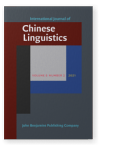Vol. 8:2 (2021) ► pp.204–240
On the conditional marker “zhě”(者)
The interaction of nominalization, topicality, and conditionality
This paper aims to explain the development of “zhě” serving as a conditional marker mainly in Late Archaic Chinese and to show that the conditional marker “zhě” derives from the nominalizer “zhě”. The grammaticalization of “zhě” is at the level of pragmatic inference, which shows an interaction of nominalization, topicality, and conditionality. Nominalization directly makes the original clause lose its ability to confirm the factuality of the event, and the nominalized construction then is endowed with a generic meaning, which is in some way related to conditionals. Specifically, the contexts triggering this grammaticalization can be summarized as follows: Firstly, the construction “VP/clause + zhě” always occupies the topic position; secondly, VPs/clauses in that construction always represent a kind of non-factual event, which means that the semantic feature of the VPs/clauses is non-factual or unreal. Furthermore, there are two clues, namely modal auxiliary and negator, which can help identify the non-factual event.
Article outline
- 1.Introduction
- 2.The multifunctional zhě
- 2.1Nominalization
- 2.1.1Agent nominalizer
- 2.1.2Common nominalizer
- 2.1.3Two hierarchies related to nominalization
- 2.2Topicality
- 2.3Conditionality
- 2.1Nominalization
- 3.The grammaticalization of zhě
- 3.1Non-factual meaning
- 3.2The bridging context – the interaction of nominalization, topic structure and conditionality
- 3.3The conventionalization stage
- 3.4Other data for supporting this analysis
- 3.5Similar phenomena from Modern Sinitic Languages
- 4.Summary
- Acknowledgments
- Notes
- Abbreviations
-
References
